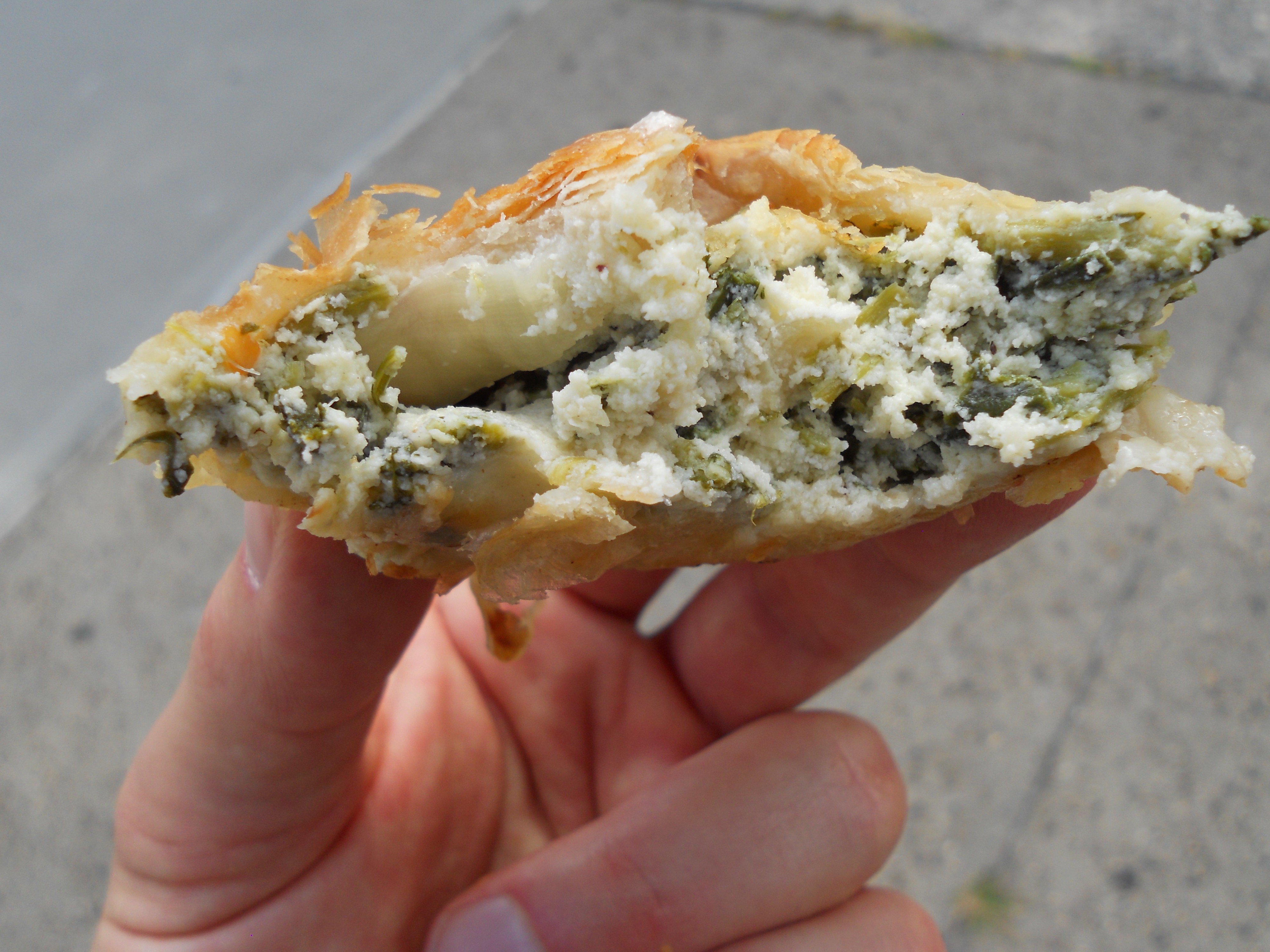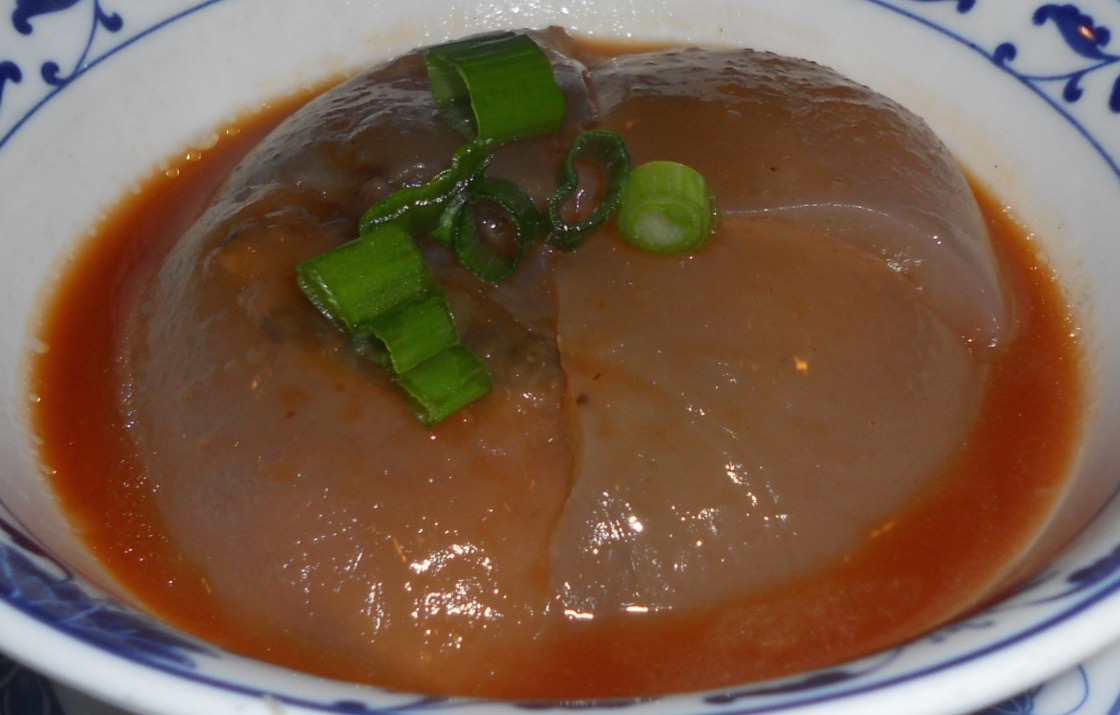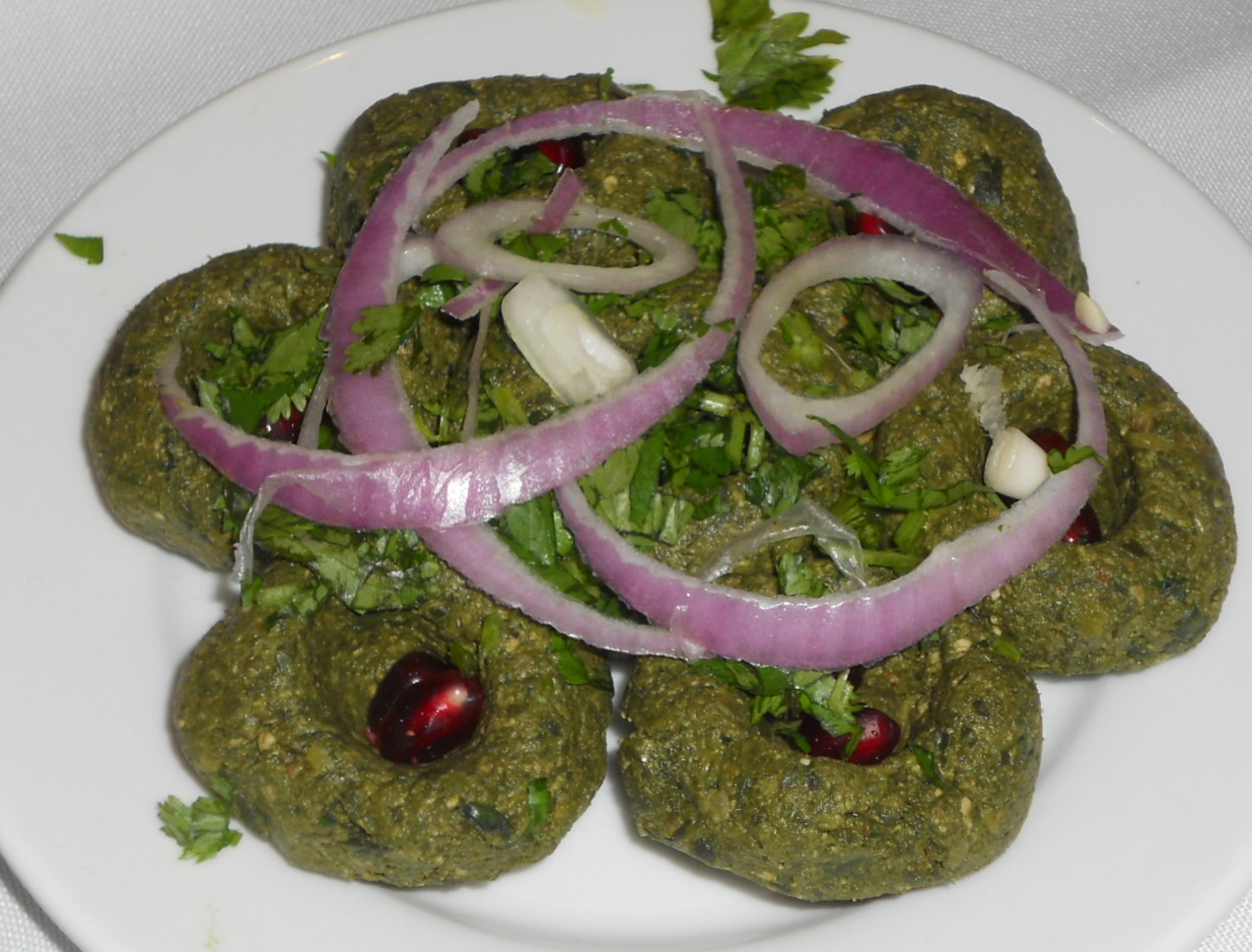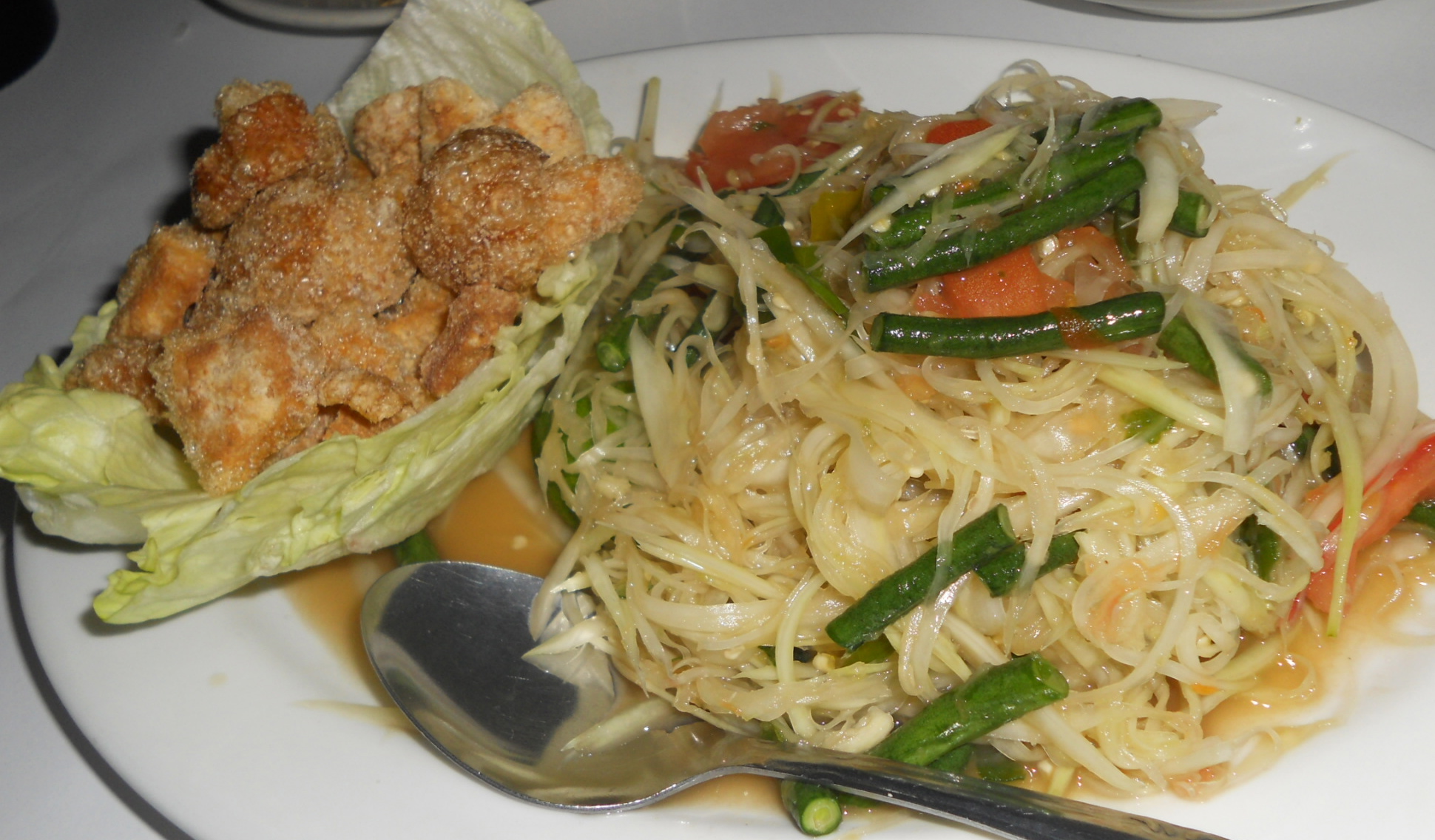|
|
So you know how sometimes you’re in a hurry, and you slam on the brakes at a stoplight after just barely missing your chance to run through the yellow light? And then it seems to take forever for the light to turn green again. And then you’re cranky? Like, just a little bit?
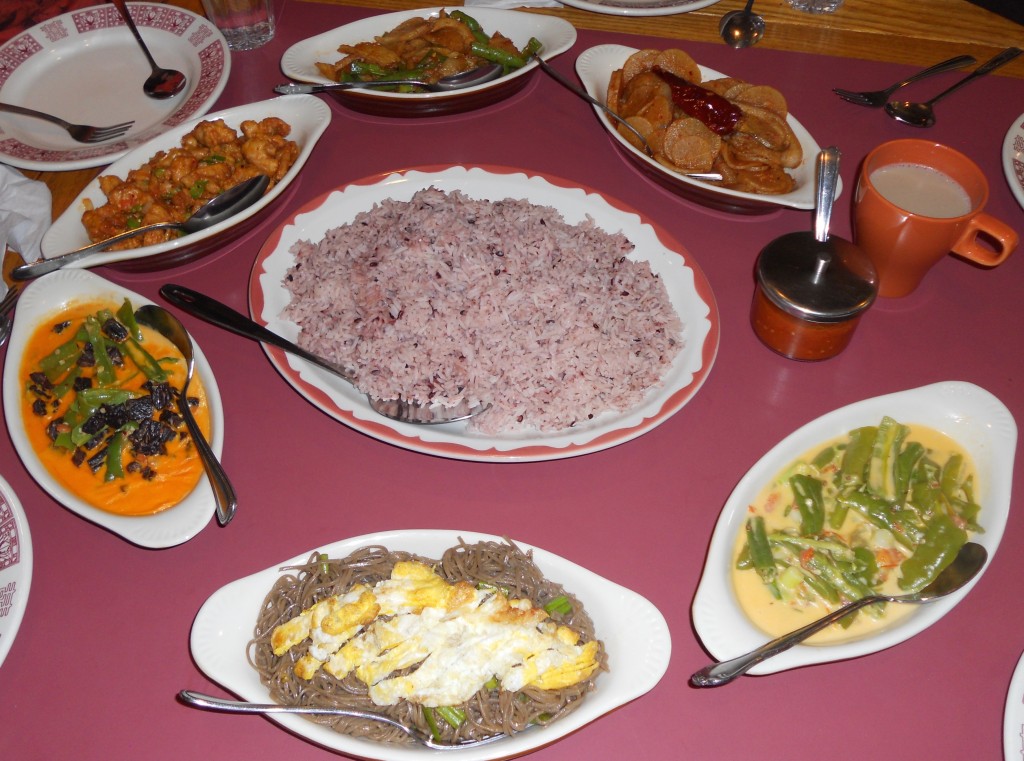 here, stick this in your mouth — your mood will improve
Well, that doesn’t happen in Bhutan, which is a nominee for the title of the world’s most fascinating small country. Bhutan is one of the very few nations in the world that has no traffic lights. Bhutan is also famous for its 1972 announcement that it doesn’t really care about Gross National Product, and would instead begin to measure Gross National Happiness.
Even Bhutan’s national dish is fascinating. (Warning: this may sound deceptively un-delicious.) Ema datsi (or ema datshi in some spellings) is traditionally made from yak cheese and hot peppers, served over Bhutanese red rice. As luck would have it, Bhutanese Ema Datsi is also the name of New York City’s only Bhutanese restaurant. And both the restaurant and its eponymous dish are more delicious than they may sound, even if yak cheese is awfully tough to find in the United States.
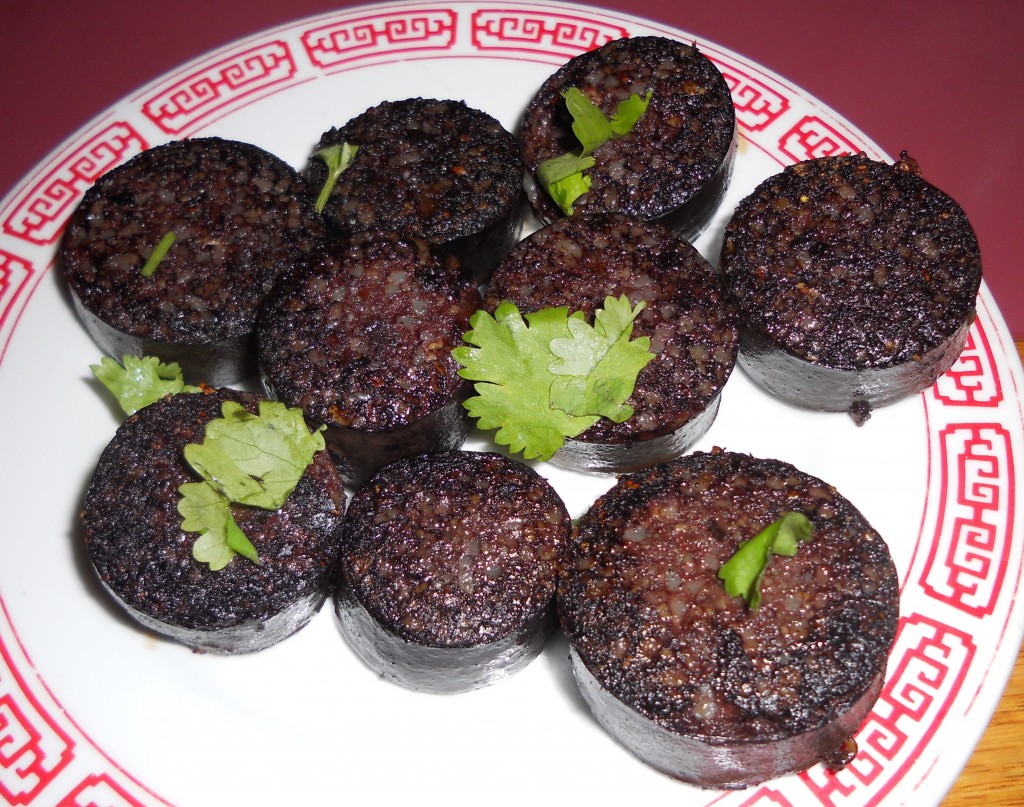 blood sausage is also way more delicious than it sometimes sounds…
Like many “small country” restaurants in New York, Bhutanese Ema Datsi serves dishes from a mix of ethnicities; the Tibetan and Indian sections of the menu are just as long as the Bhutanese section. When the six of us (including the guy who should write your next theme song and a dolphin-chomping journalist) sat down, we immediately asked the charmingly soft-spoken server which appetizers were Bhutanese. He identified two for us: “cauliflower dry” ($5.99) – a tasty sauté of cauliflower, scallions, and hot peppers – and gyuma ($8.99), Bhutan’s version of blood sausage. The gyuma is stuffed with a roasted flour called tsampa, usually made from a mix of wheat and barley, that also appears in Mongolian butter tea. The gyuma is spectacular, served in crispy, fried rounds, with a nice hint of hot peppers; it was perhaps even better than the excellent Puerto Rican stuff, and blissfully avoided the blood sausage scourge of sweet, mushy, gritty bloodiness.
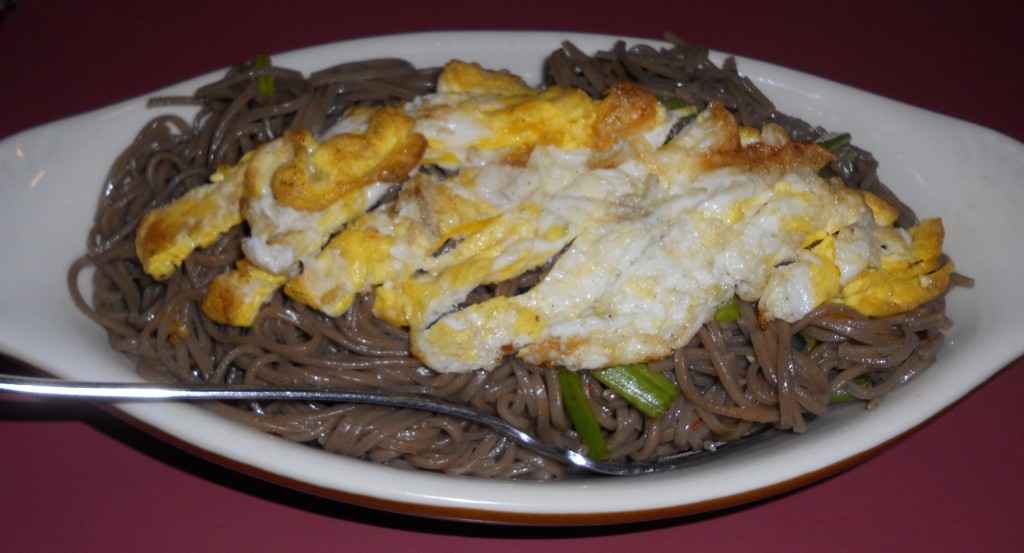 Puta! (No really, I swear that I’m not swearing.)
For our main dishes, the six of us shared six entrees. Three of the dishes were excellent, if not incredibly exotic-sounding: “fried chicken spicy monpa style”, consisting of chunks of pan-fried chicken with onion, chili, and garlic; phak sha paa thali, featuring chunks of sautéed radish and fresh pork, seasoned with a moderate dose of onions, garlic, and hot peppers; and puta, a vulgar Spanish word a simple dish consisting of buckwheat noodles with butter, green chilis, scallions, onions, peppercorns, and a fried egg ($7.99). If you’re dining with a pal who has an aversion to cheese or tripe or spice, these are three solid choices, and the fried chicken is particularly tasty.
We couldn’t resist trying the tripe, which I sometimes pretend is my new favorite thing. The Bhutanese version, called goep, was nicely spiced with garlic, onion, tomato, and chili powder, but it was a little bit on the chewy side, which isn’t necessarily a bad thing; a little bit more cooking, and it would have resembled the consistency of the tasty Korean fish cakes that I love.
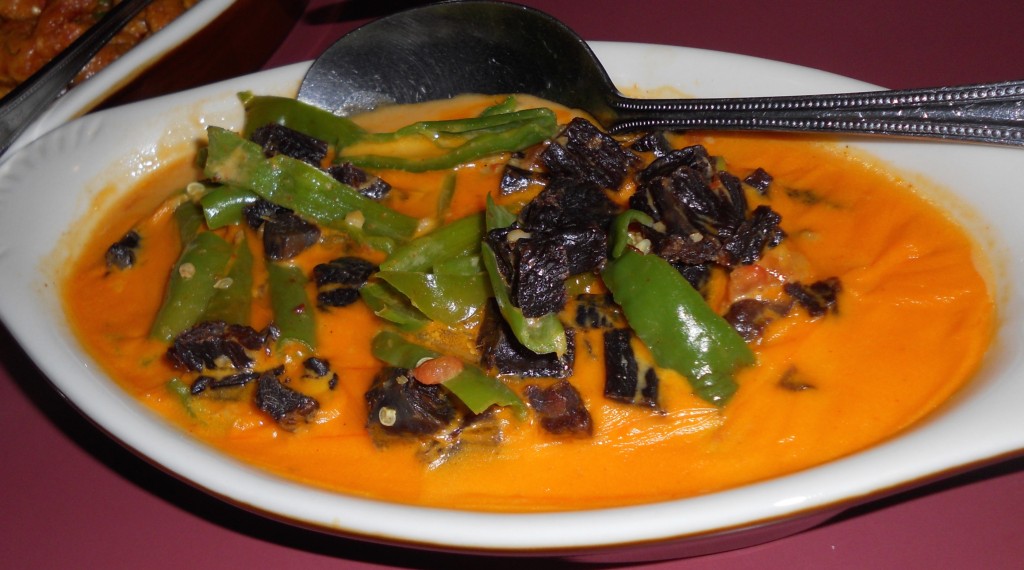 gloriously cheesy, but lamentably yakless
The final two entrees were also the most gloriously cheesy. The sha kam thali ($9.99) featured chunks of dried beef and hot green chilis in an orange-colored cheese sauce; the restaurant’s eponymous ema datsi ($7.99) was slightly spicier, with the dried beef swapped for extra hot peppers and a lighter-hued cheese sauce. Both were irrationally delicious: we’re talking about hot peppers and maybe beef jerky, stewed in something that vaguely resembles a runny version of nacho cheese. That shouldn’t be good. But it was, and like at least one other NYC food blogger, I can’t for the life of me understand why it was so fantastic.
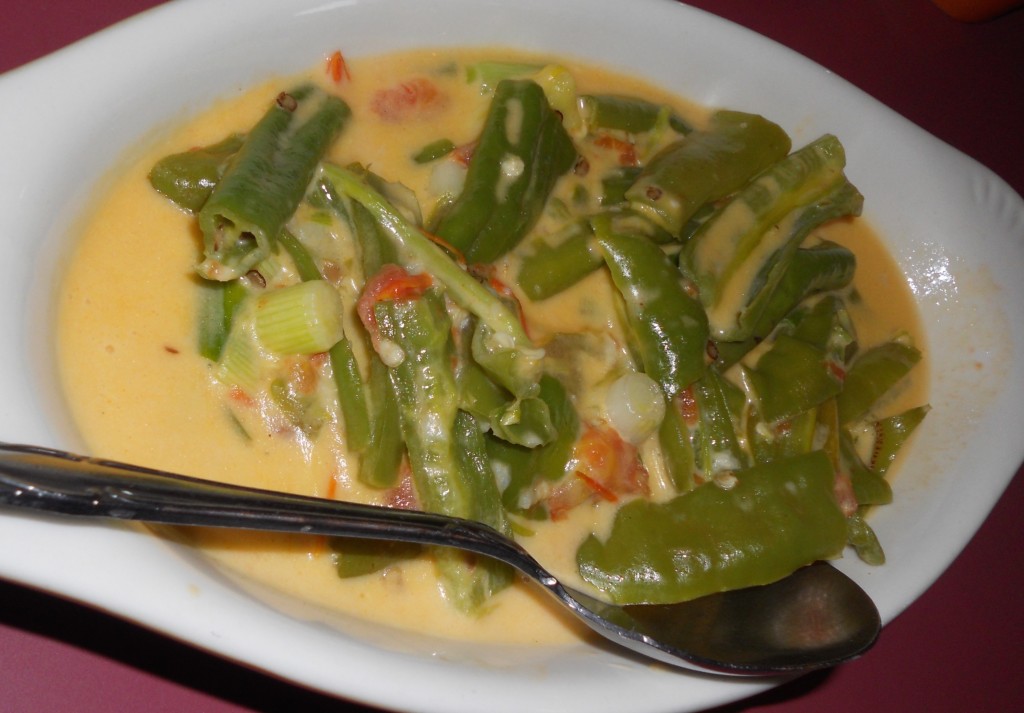 nope, not Velveeta…
The answer is not yak. The charming owner, most likely attracted by the gigantic grins on our protruding bellies faces, came over a few times to chat. He explained that ema datsi is normally made from yak cheese, but yak udders, of course, are rarely utilized to their full potential in the United States. He also explained that the ema datsi is normally made from another type of hot pepper, hotter than Thai chilis. These were moderately hot – not a challenge for people with Capsaicin Machismo Syndrome (not to be confused with PMS, or Porcine Machismo Syndrome), but downright deadly to say, my Iowan relatives who are convinced that pickle relish is spicy.
So yeah: Bhutan’s royal family is convinced that Gross National Happiness is a better way to think about national success than Gross National Product. And I think they’re right: we all ate gross amounts of food, and then we were happy. See? It worked.
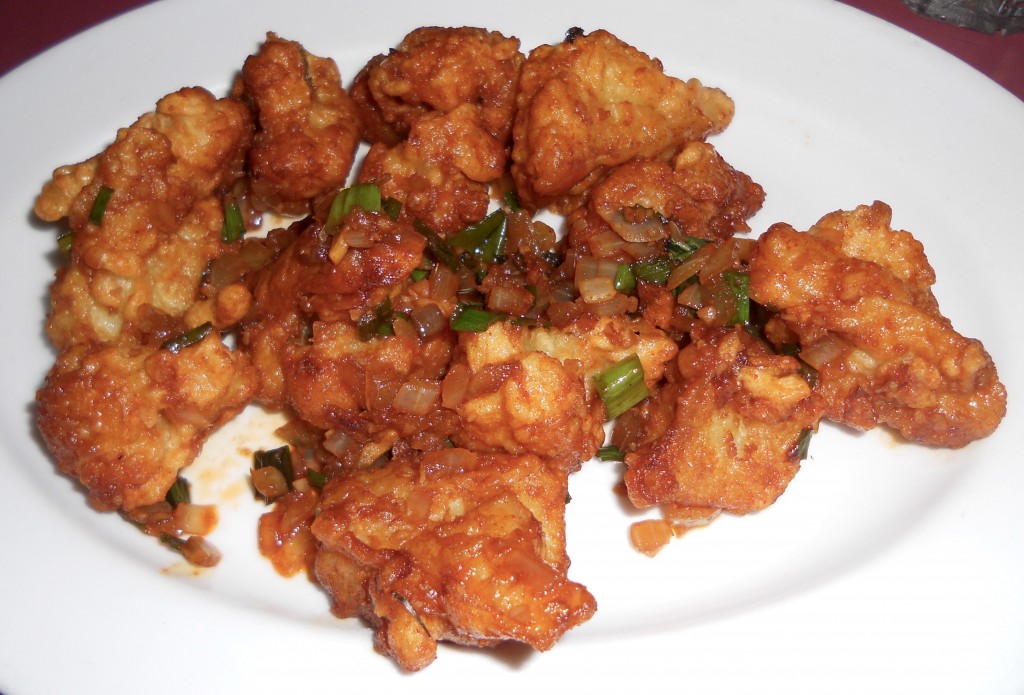 even the cauliflower inspires gross happiness 
Bhutanese Ema Datsi
67-21 Woodside Avenue
Subway: 69th Street (7 train)
|
|
|
I enjoy making really stupid jokes about how I eat too much and may look like I’ve swallowed several whales. Of course, I haven’t actually swallowed several whales. Just one, really. And not the whole thing. And maybe it was a dolphin. I don’t know. I was bad at Biology in high school.
On a gorgeous fall afternoon, I attended the annual Saint Lucia Jounen Kweyol (Creole Festival), which was held this year at The Pacific BK, an event center in Crown Heights. In case you’re not familiar with Saint Lucia: it’s a small, independent island nation in the Caribbean, somewhere between Martinique, Barbados, and Saint Vincent and the Grenadines. Saint Lucia has a population of around 174,000, and the island is petite enough to make Puerto Rico look like a freaking sumo.
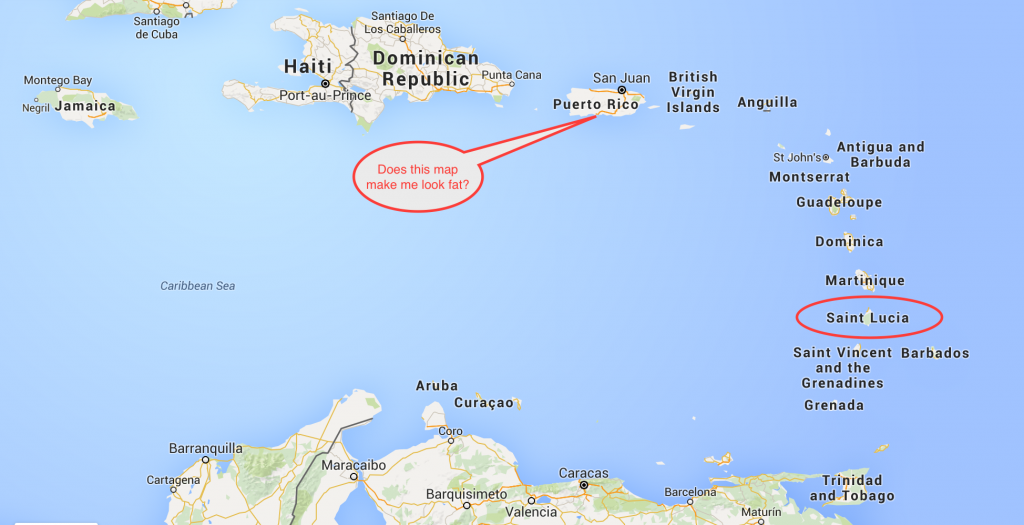
My favorite fun fact about Saint Lucia: it has more Nobel Prize winners per capita than any other nation in the world. That might be because there aren’t all that many capitas – whatever those may be – in Saint Lucia. But still.
The other fun fact about Saint Lucia is that Saint Lucians – at least the ones that reside in New York – are really fun at parties. When we first arrived at the festival early on a Sunday afternoon, there were several hundred people crammed into a smallish, enclosed parking lot; the perimeter of the lot was completely filled by six food vendors, a makeshift bar, and a stage with steel pans and a DJ. The food-to-space ratio was magnificent, and so was the hospitality of the Saint Lucians we met.
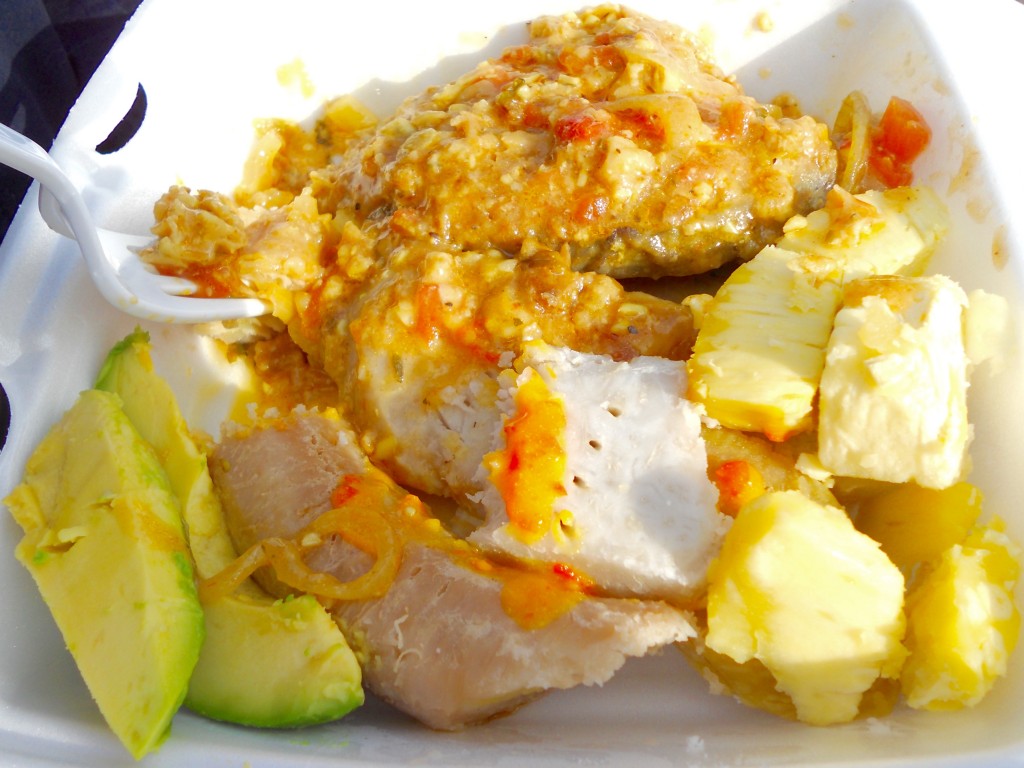 magnificent creole fish and avocado… much of which might end up on my chin
When we arrived, the three of us – a wise Canadian journalist, a globetrotting Bangladeshi investment banker, and this weirdo – might have stuck out just a little bit in a crowd of Saint Lucians. But that might have been a good thing. The event was emceed by a charismatic, dapper middle-aged fellow in a hat and jacket, speaking in the Saint Lucian dialect of Creole French as he meandered through the crowd with a wireless microphone; I had no idea what he was saying, but he and the audience chuckled at his jokes every few seconds.
As all three of us non-Saint Lucians chowed down on our second courses, the dapper emcee suddenly switched to English and apologized for mostly speaking in Creole, but said that he was very excited to see friends from other nations and that he really wanted everybody from every nationality to feel at home at the celebration. I had a feeling that he was looking at us. I looked around, and finally saw him.
Yup, staring right at us.
I looked up from my feast, wiped some avocado off my chin, and grinned broadly. He came over, repeated his gushing welcome, and said that he really hoped we were enjoying the Saint Lucian food and culture and music. When he said “food”, my ears involuntarily twitched, and I involuntarily grinned even more broadly. He then came over with the microphone, asked where we were from, asked if we were enjoying our food (duh), and then continued to remind us that we were heartily welcome to enjoy the celebration and that we should ask friendly Saint Lucians for translations of his Creole. And he also said that we should definitely try the excellent Saint Lucian rum. (Yes, sir!)
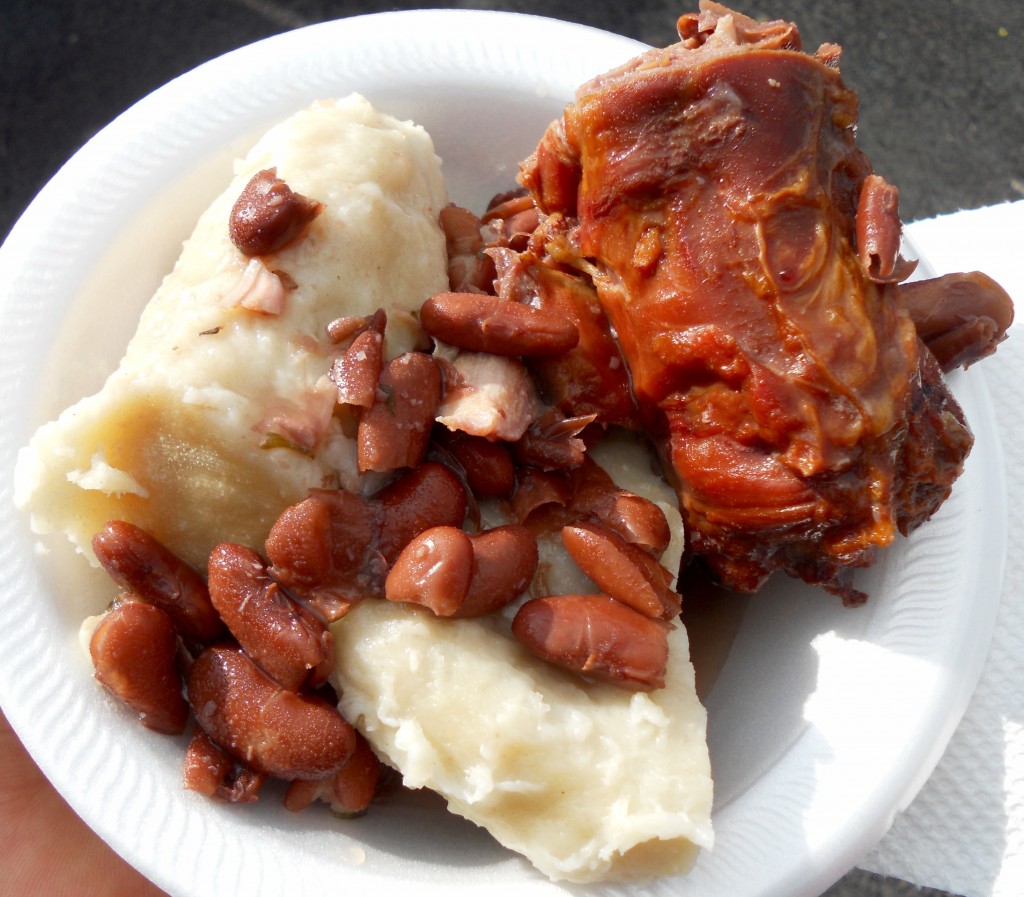 dumplins, beans, and turkey neck
The emcee wasn’t the only Saint Lucian to go out of their way to welcome us. Several people approached us, just to ask if we were enjoying the food and music. One food vendor asked if I came last year, because I looked familiar; another gentleman came up to me, and asked if I’d attended his church, because I looked like somebody who did. Apparently, my doppelganger also loves hanging out with Saint Lucians.
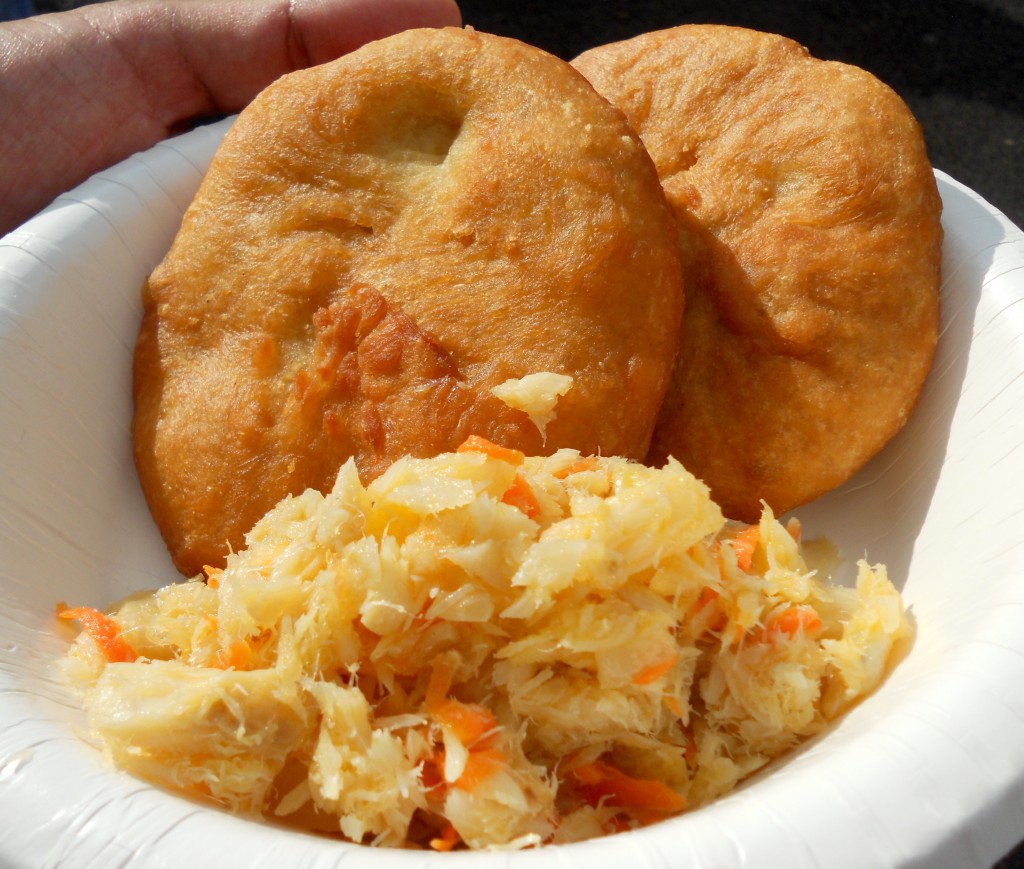 my doppelganger probably likes bakes and saltfish, too?
And then there was the food, which was hearty, interesting, and delicious. We started with dumplins with red beans and turkey neck, stewed dumplins with pork, and a plate of bakes (fried dough, roughly the size of a small, flat hamburger bun) with saltfish. None of those dishes were exactly light, but we kept going, and each of us ordered full entrees “with provisions” – the magic phrase that yields big chunks of avocado, green plantain, ripe plantain, breadfruit, and yucca with your meal. One of my pals opted for stewed pork with his provisions; another chose creole fish, consisting of a large, gorgeous chunk of flaky whitefish, stewed in a deliciously garlicky sauce with a full complement of peppers.
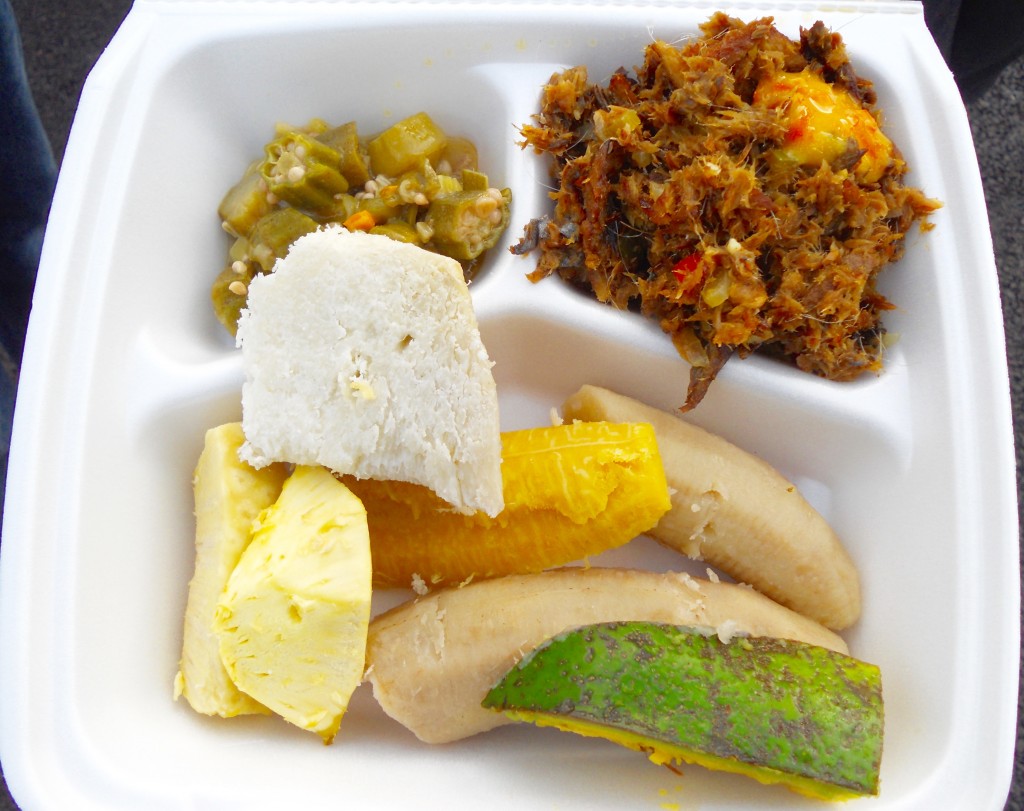 sorry herring, I’ll never insult you again
I ordered a plate of smoked herring, partly because I still owe herring an apology for being afraid of it for all of those years, and partly because it looked really interesting, with multicolored flecks of peppers and onions, along with some feathery white bones. It was a fantastic dish – peppery and charmingly salty, and a perfect accompaniment to a nice chunk of breadfruit with okra.
After each of us had eaten a hearty appetizer and a hefty plate of protein with even heftier provisions, we really didn’t need to eat anything else, but then we spotted a woman eating a small dish filled with a greenish-black substance, dotted with chunks of what looked like red meat and cartilage. Our Canadian pal asked what it was. The woman hesitated, then sounded slightly apologetic: “Um, that’s called blackfish. You might think this is weird, but it’s actually dolphin. In our culture, that’s normal – it’s something we eat all the time.”
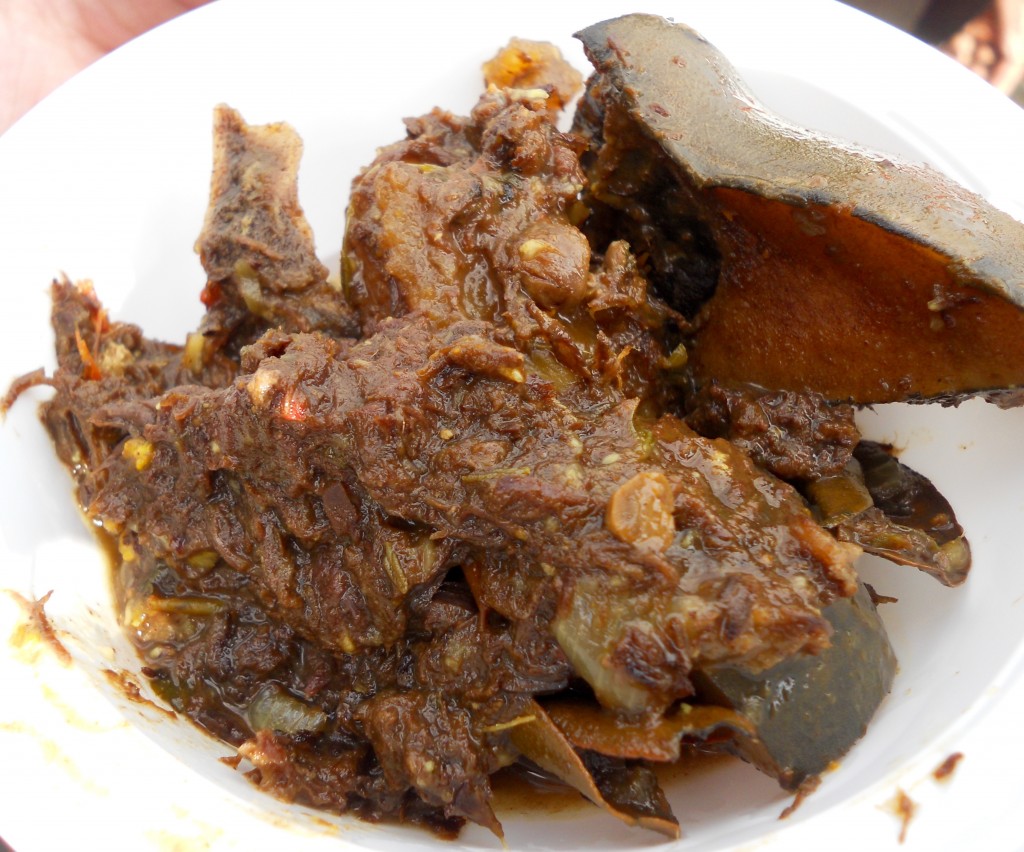 a selfie… no wait, that’s not me, it’s a different piece of spicy blubber
Well, when in Rome: let’s eat dolphin! (Cue the hate mail.) A tiny bowl of the stuff was relatively expensive ($10) and not terribly photogenic; the sauce was incredibly rich, with an amalgam of peppers and spices that I couldn’t quite place. The lean meat itself could easily be mistaken for a piece of dark meat, perhaps lamb or roasted pork; the blubber was firm and chewy, and actually pretty tasty in the greenish-black sauce, not too dissimilar from the texture of a nice piece of roasted pork skin.
Another friendly Saint Lucian bystander struck up a conversation, and explained that the blackfish was made from pilot whale – which is actually a member of the dolphin family, and not technically a whale. (Cue more hate mail.) And it turns out that the pilot whale is NOT a threatened species. (Thank you to Wikipedia for making us feel slightly less evil. But cue the hate mail, anyway.)
As soon as the three of us finished devouring our dolphin/whale snack, yet another smiling Saint Lucian woman approached us. The conversation went something like this:
Friendly Saint Lucian: Ah, you’re eating the blackfish! How do you like it?
Me: We love it! There are some great flavors in here.
Friendly Saint Lucian: Oh, I’m so glad you like our food! I made that, you know.
Me (swooning): It’s fantastic, I love it! What else is in here, besides the fish itself?
Friendly Saint Lucian: Peppers, bay leaf…
Me (rudely interrupting, and poking at a different leaf that remained on the plate): What’s this other leaf?
Saint Lucian: That’s the leaf of the cinnamon tree. You can’t eat them, though.
Me: I already ate three of them.
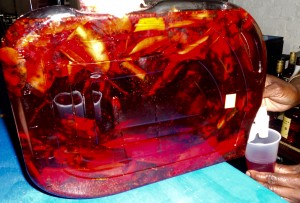 “hardwood” It’s totally possible that chomping those cinnamon leaves made me see double later in the afternoon. That, or it was the homemade rum drink (loosely translated as “hardwood”) that we purchased from another gregarious pair of Saint Lucians who staffed the indoor bar. “Hardwood” is rum infused with a variety of Saint Lucian herbs and roots; it has a pungent herbal taste, with a pleasant dose of bitterness, a hint of sweetness, and plenty of fire, vaguely reminiscent of a stronger-flavored version of Campari. I was an instant fan.
The warm, talkative pair behind the bar served the “hardwood” with a strong warning: “This makes the ladies get pregnant right away!” Fortunately, our wives were out of the country. And that’s good, because our wives might have totally hated us for eating a member of the dolphin family.
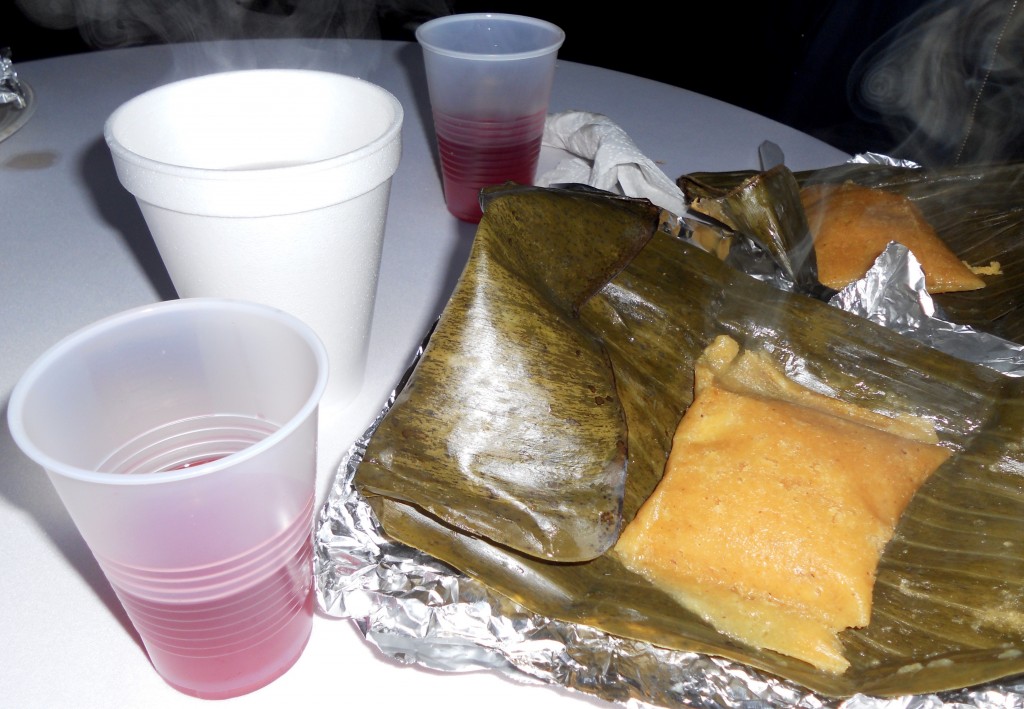 But our wives would totally forgive us if we offered them dessert and bay leaf tea… um, right?
And if that wasn’t enough, we couldn’t resist trying a Saint Lucian dessert called pami, a dense, delicious bundle of cornmeal and coconut, wrapped in a banana leaf. We washed it down with some bay leaf tea (interesting, right?) and… well, more “hardwood.”
So yeah, all of those Nobel Prize winners from Saint Lucia? There would be even more if somebody gave out a Nobel Prize for food and hospitality. My doppelganger’s doppelganger will be back next year, friends.
St. Lucia Jounen Kweyol
2015 event held on October 25
The Pacific BK
1065 Pacific Street, Brooklyn
This post was not sponsored by the Saint Lucia Tourism and Visitors Bureau, but I really wish that it was. Hint, hint?
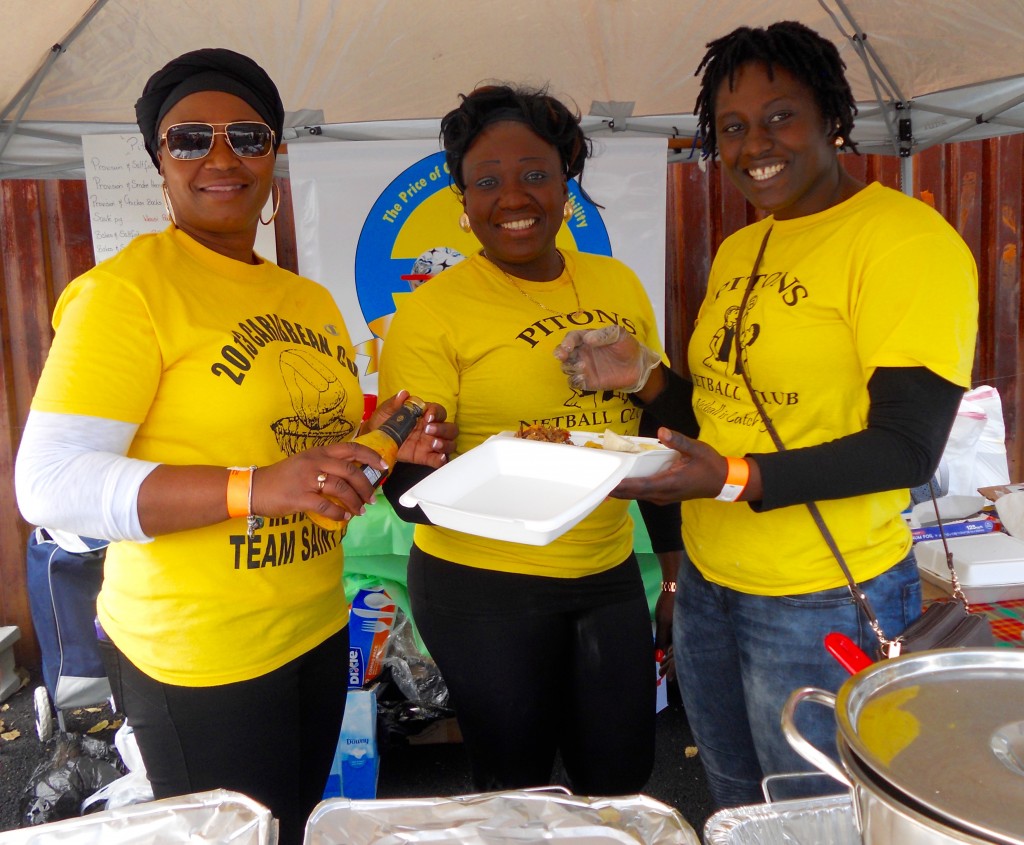 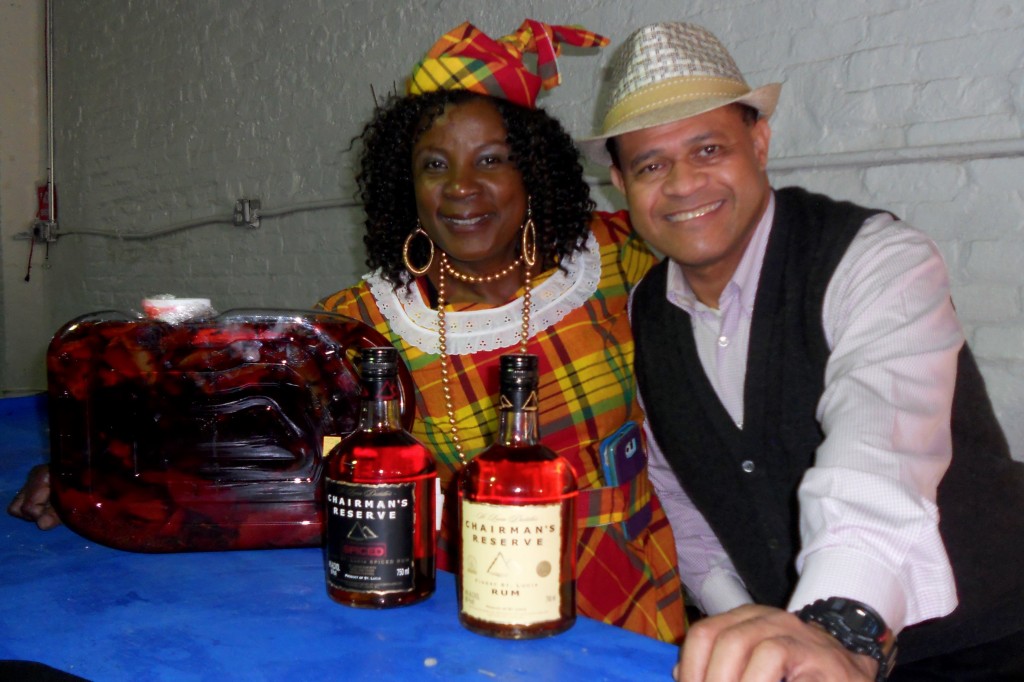 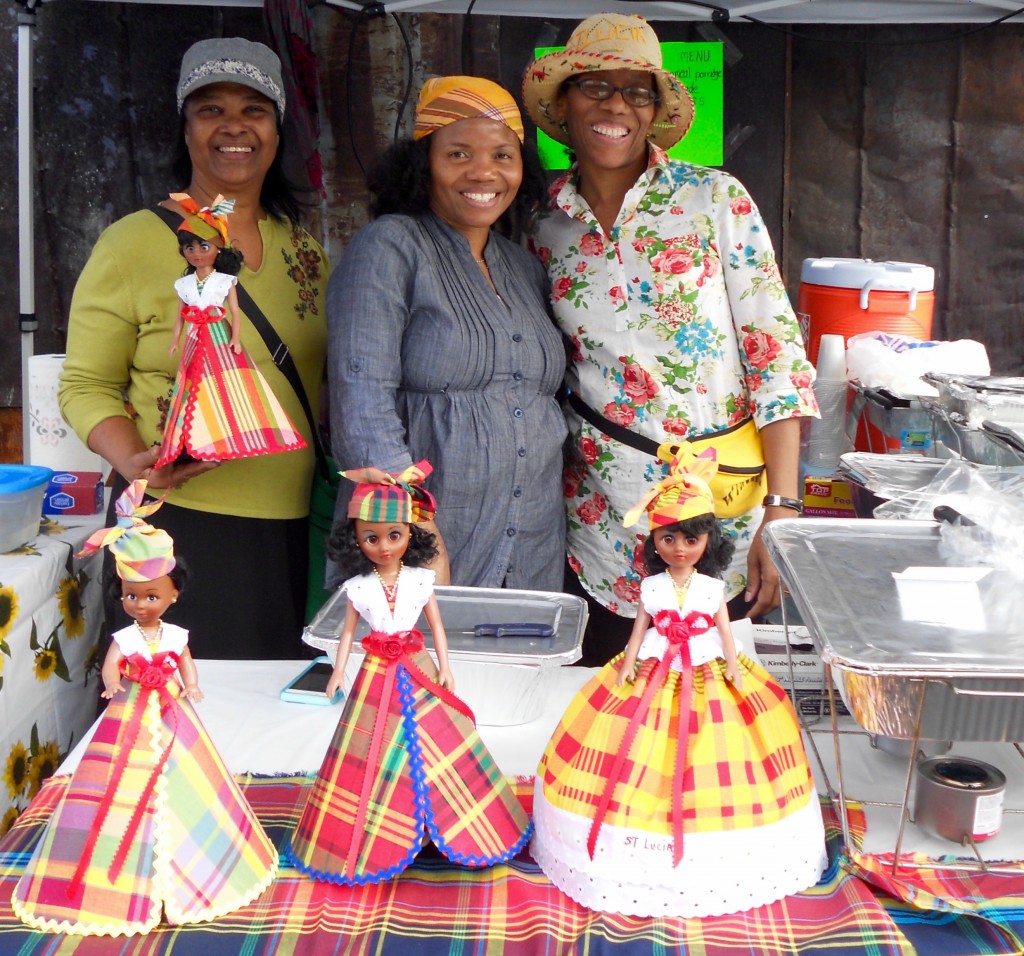 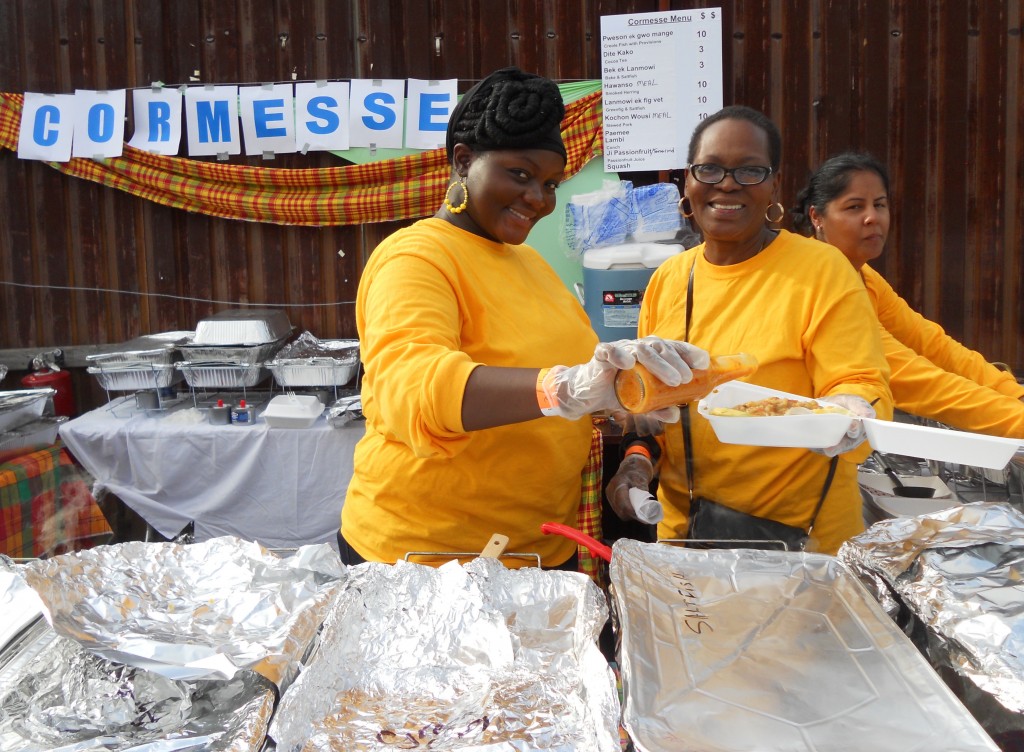
|
|
|
If you’ve ever visited this lardy corner of the internet, you know that I rarely gush about food. Oh, wait… yeah, OK, fine. I do. But I don’t usually gush about food outside of NYC unless it’s something special.
On a recommendation from a Peruvian pal from New Jersey, I deliberately engineered a layover in Miami a few months ago, primarily to eat Peruvian food. And also to go canoeing in the Everglades with the alligators and crocodiles — which, for whatever it’s worth, I strongly recommend, even if you don’t plan to eat the crocodiles. It’s crazy fun, though not quite as much fun as a huge plate of Peruvian chicken. Then again, not all that many things are as fun as Peruvian chicken, except for maybe Peruvian ceviche, or Peruvian beef in cilantro sauce, or a really great plate of Peruvian lomito with fries, or some Peruvian empanadas.
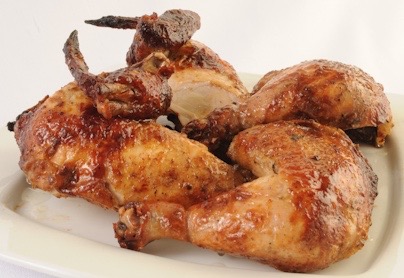 my idea of fun
Wait… where was I? Right. Miami. Got it. On my pal’s advice, I headed to a place called El Pollo Inka, almost literally within spitting distance of the Miami airport. It’s one of those places that’s buried in a two-story strip mall, with multiple South American restaurants sharing the same parking lot. I’m sure that the others are perfectly lovely, but stay focused: El Pollo Inka is all you really need.
As you may have figured out, I’m a fan of Peruvian food, and El Pollo Inka absolutely nails many of the classics: great pisco sours, an excellent rendition of chicha (a sweet punch made from fermented purple corn), perfect roasted chicken, and outstanding ceviche. But where the place really shines is in a few of its lesser-known dishes, including the rare treat of purple sushi rolls.
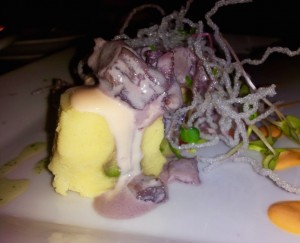 my purpler idea of fun
Yes, purple Peruvian sushi rolls. They’re called causa rolls, and they aren’t exactly dainty: chunks of unusually tender octopus and avocado, rolled in a layer of potato and topped with a tangy sauce made from a deliciously pungent Peruvian olive. It’s amazing, and possibly the first sushi-like dish I’ve ever encountered that was actually filling. I love Japanese-style sushi, but I’m a really expensive date at a typical sushi joint. (Related: does your corporate AMEX card want to take me out on a sushi date? Huh? Huh? Please?)
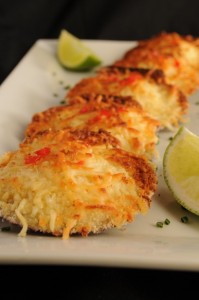 the only scallop dish hearty enough to make my vision a lil’ blurry Another hit was El Pollo Inka’s conchitas a la parmesana — scallops in a half-shell, baked with white wine and Parmesan cheese. Definitely not a light appetizer, but pretty darned phenomenal.
The place is, in a sense, the holy grail of restaurants. Excellent execution of Peruvian classics like ceviche and roasted chicken? Yup. Great pisco sours? Hells yeah. Reasonable prices? Sure. But the place deserves some serious bonus points for creative, gut-busting, off-the-beaten path dishes that aren’t offered in all that many Peruvian restaurants in the United States.
So if you’re flying somewhere – like, I don’t know, how about from New York to Boston or something – it really isn’t hard to arrange a layover at El Pollo Inka – er, I mean, the Miami International Airport. That’s, like, totally worth it for Peruvian food, right?
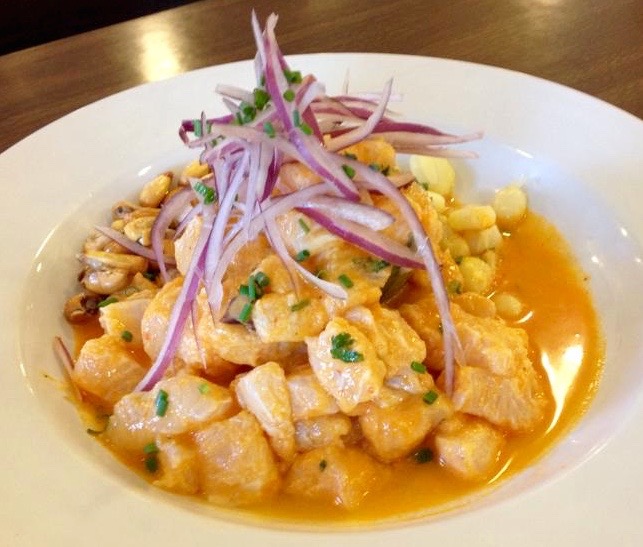 Can I use my SkyMiles to buy ceviche?

El Pollo Inka
7285 NW 36th St, Miami, FL
Transit: I recommend Delta, mostly because of those cinnamon cookies they serve on flights
|
|
|
I’m not sure how, but I somehow heard torrid internet rumors about this thing called laverbread. It’s a Welsh “bread” made from seaweed and oatmeal, generally eaten at breakfast. Yes, Welsh seaweed bread. Um, wut? That sounded pretty awesome.
As luck would have it, there’s a Welsh-themed pub in Astoria called Snowdonia that serves the stuff as part of its Welsh breakfast. Though none of Snowdonia’s owners are natives of Wales, I may look like I’ve swallowed several whales one of the owners is of Welsh descent, and the pub has received the stamp of approval of the Welsh government. Pretty cool.
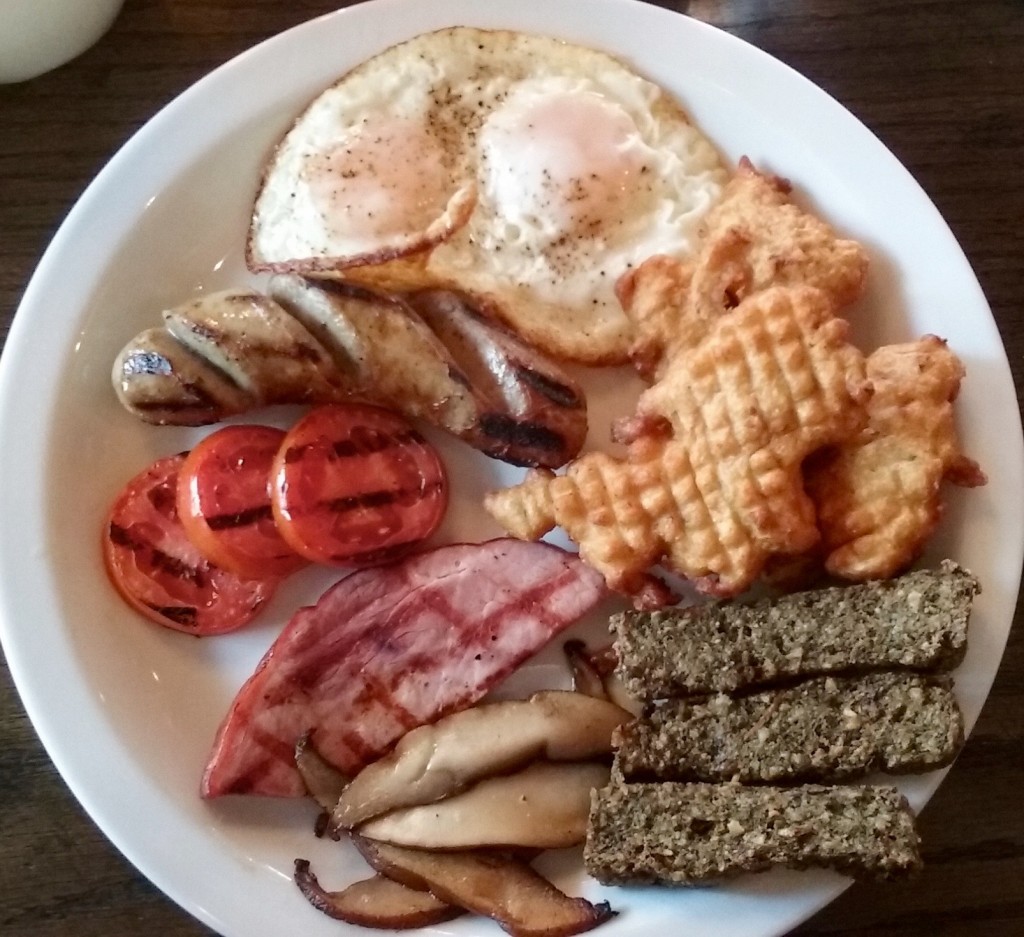 and this receives the stamp of approval from my second and third chins
On weekends (and Mondays, interestingly), Snowdonia offers a full Welsh breakfast ($19, with Monday discounts for service and entertainment industry professionals), consisting of two fried eggs, a large fried breakfast sausage, three sticks of fried laverbread, three fried cockle fritters, some fried tomato slices, a chunk of fried ham, and some fried Portobello mushroom slices. The (wonderful!) server might have told me that some of these things were allegedly grilled, but I couldn’t hear her over the smell of my arteries clogging. But don’t worry: they were smiling broadly as they clogged.
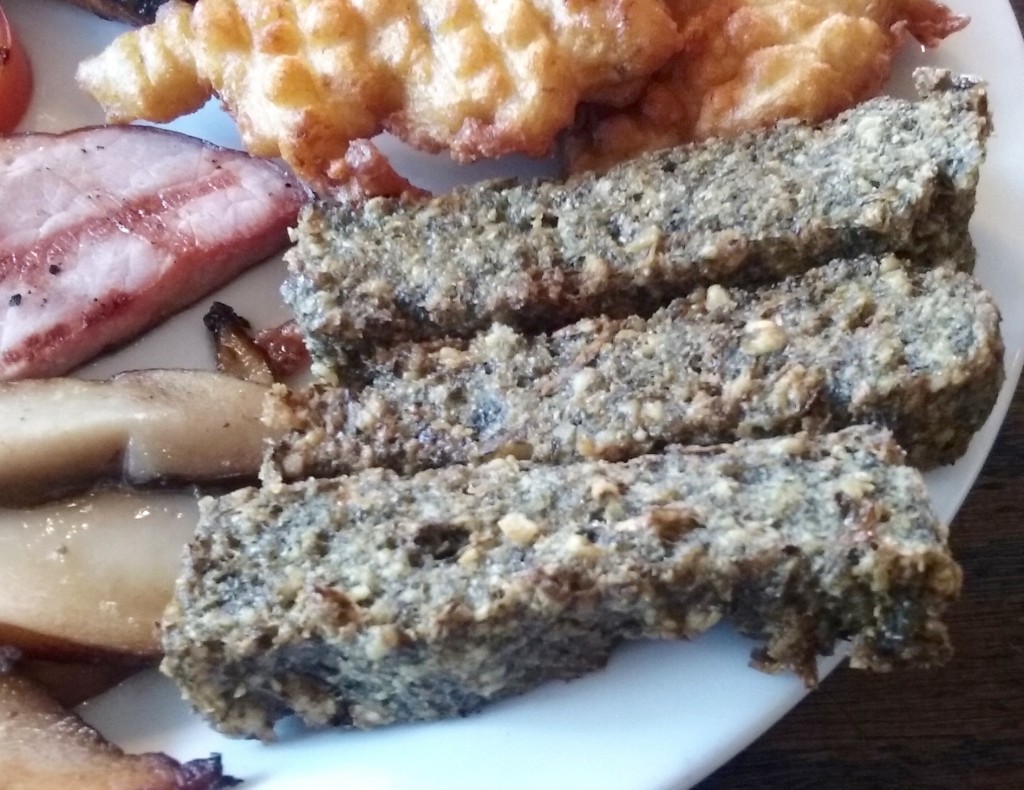 it’s green, so it’s probably healthy, right?
The laverbread is interesting, but I don’t know that it’s meant to be particularly delicious. It’s bland and slightly chalky, unfortunately. I somehow thought that seaweed bread would taste a little bit ocean-y or fishy, but nope: I could tell that I was eating something green, but I probably wouldn’t have guessed that it was seaweed. Still, the laverbread wasn’t too bad when accompanied with some sausage and a runny egg.
The other bread-like items on my plate were cockle fritters, which were more appealing than the laverbread. If you’re not familiar with them, cockles are misspelled reproductive organs smallish shell-clad sea creatures, and small bits of the buggers were imbedded in some doughnut-like things on my plate. The fritters were excellent, but didn’t really taste terribly fishy; if you had told me that they were mushroom fritters, I might have believed you.
 pretty sure this fork is giving me the heavy-metal salute just because I’m good at eating But still: I was eating a plate of food that had, like, eight different fried things on it! That’s awesome. I’m such a good eater that plastic forks sometimes offer the heavy-metal salute in honor of my stomach’s prowess. So that plate of fried stuff was no match for my epic gut.
And then reality struck: man, that was a lot of fried stuff for a Monday brunch, and I was hurting a bit as I rounded the three-quarter mark in the meal. But I kept eating. You see, my doctor diagnosed me with a disorder called Porcine Machismo Syndrome (PMS). PMS is actually a type of testosterone poisoning, and it causes sufferers to twitch uncontrollably if a plate of food threatens to defeat them. If left untreated, this disease can cause a secondary infection called Bigfatfuckitis.
Fortunately, I treated my condition with more fried stuff. As soon as I started to twitch, I took another bite. I was putting forth so much effort that little beads of sweat lipids formed on my brow. And finally, after many deep breaths, I finished the plate and promptly exploded drank a lot of Diet Coke so that I could pretend that I’d eaten a healthy meal.
Wait, nevermind: I ate Welsh seaweed bread! That was totally pretty much a salad, right?
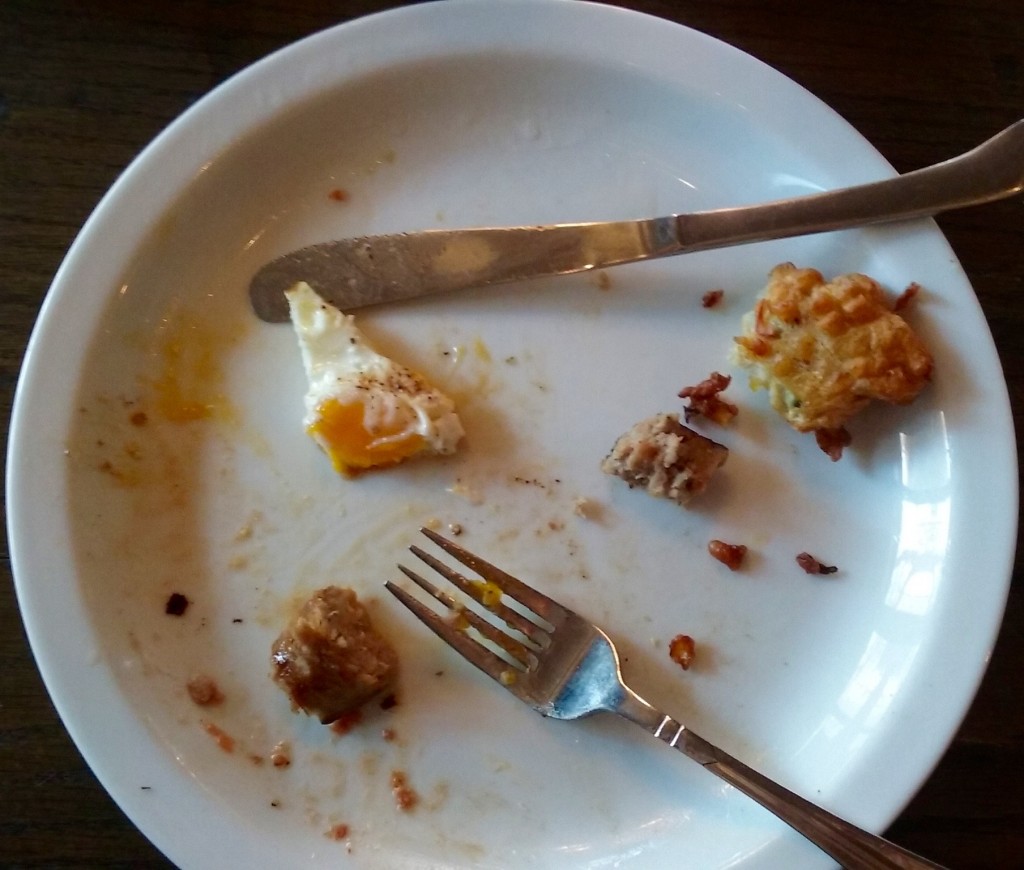 this last bite hurt a little bit, but I’m totally sure that it cured my PMS 
Snowdonia
34-55 32nd Street, Astoria
Subway: 36th Ave. (N, Q trains)
|
|
|
I grew up in a small town in Iowa, where it was easy enough to explore pretty much every corner of the community. There really weren’t a lot of surprises in a town of 45,000 people – sure, you could end up in the wrong cornfield or whatever, but was unlikely that you’d ever encounter a completely new community. Communities of livestock, after all, tend to be fairly homogenous.
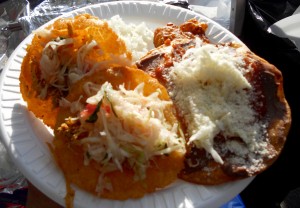 far from an Iowa cornfield, but fried corn still makes everybody happy In comparison, New York City feels almost infinite, and the city has massive ethnic communities that most New Yorkers have never even heard of. Take, for example, the Garifuna: there are somewhere between 100,000 and 200,000 Garifuna – descendants of rebelled slaves who ultimately settled on the Caribbean coast of Central America – in the five boroughs, depending on whose estimate you believe. And if you walk up to a white Manhattanite and ask them where to find the Garifuna, they’ll give you a cranky look, hastily gesture toward the nearest Duane Reade, and pretend that something very, very important just happened on their phone.
However, if you ask a friendly Garifuna where to find Garifuna cuisine, you’re likely to end up somewhere awesome, like Linden Park or Crotona Park or Ferry Point, where groups of Garifuna hold regular gatherings on summer weekends, filled with music and phenomenal food. When I was searching for Garifuna cuisine, I emailed Teofilo Colón (affectionately known within the Garifuna community as Tio Teo), the warm community leader who runs the Being Garifuna website, and asked him for help learning about Garifuna cuisine before I write about it again on my website. He graciously pointed me in the direction of an excellent 2012 Saveur article about Garifuna cuisine, and then he put me in touch with the quartet of amazing sisters who run the Garifuna catering company Weiga/Let’s Eat, including Isha G. Sumner, a model and actress who once appeared on an episode of Law & Order, in perhaps the only example of a Garifuna-language segment on an American TV show.
 The Weiga/Let’s Eat quartet, with the nephew of a Belizean tamale warlock. I don’t know who the lady on the left is, but she looks happy about tamales.
It’s pretty cool that Isha is an accomplished actress who speaks three languages. It’s even cooler that Isha and her three trilingual sisters — Emely Gutierrez, Irina Gutierrez, and Gi Martinez — are really good at cooking and eating. You should definitely check out their website or their Facebook page, and show up whenever they’re cooking and eating. They’re all phenomenally lovable people, in addition to being excellent at cooking, eating, and explaining Garifuna cuisine to rookies like us.
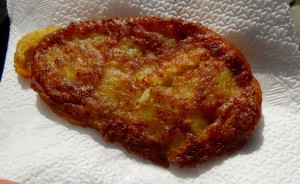 spicy conch fritters On this particular day, the Weiga/Let’s Eat contingent weren’t cooking, just eating. (Yes, I just used the words “cooking” and “eating” in four consecutive sentences. No, I can’t really think about much besides cooking and eating.) The four sisters joined my lovely wife and I for a journey to Linden Park, where a fleet of food vendors bless a two-block chunk of sidewalk on summer Sundays, along with a few other tables selling Central American-themed gifts. (Aren’t you proud of me? I actually glanced at the tables that didn’t have food! Don’t get used to it.) The majority of the food vendors were Belizean – serving a mix of Garifuna and mestizo dishes – though a handful of Honduran, Guyanese, and Trinidadian chefs were also in attendance.
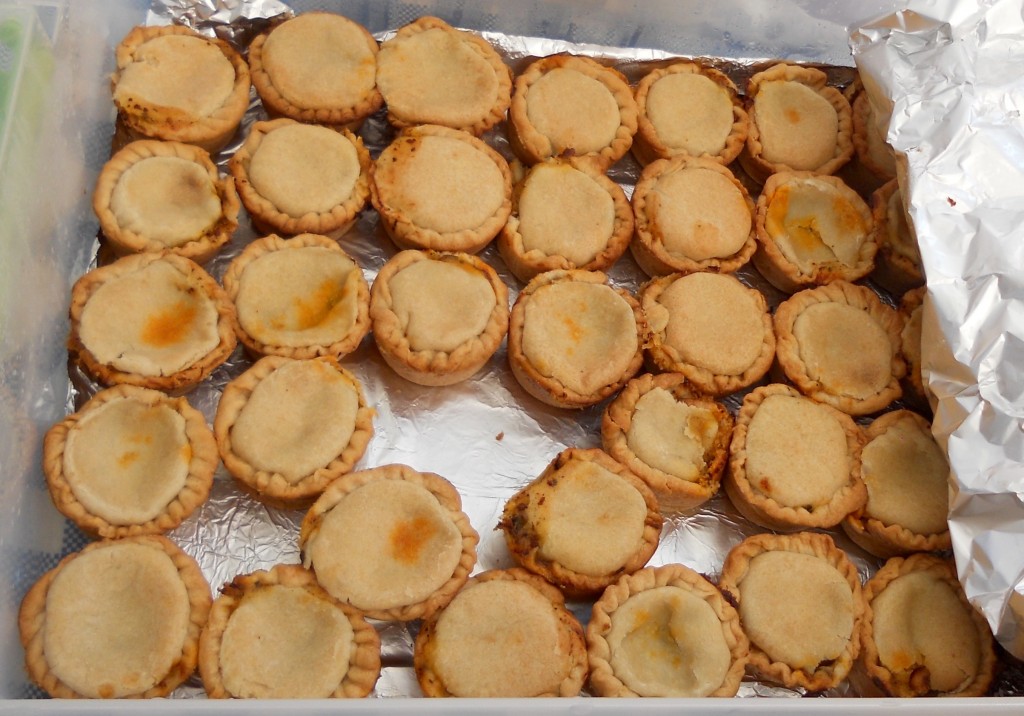 There’s no “i” in team, but there is an “i” in “Belizean meat pie”, and there are many meat pies in I. Wow, I’m bad at poetry.
I’d be lying if I said that we ate from every Belizean vendor, but we came awfully close. I sampled ten different Belizean dishes during our two-hour stay at Linden Park – and we still spent less than $25. Here, have some bullet points, because you’ll get really freaking bored if I turn this into paragraphs:
- Conch fritters ($1): they don’t look terribly photogenic, but the best of Linden Park’s conch fritters was spectacular, spiked with several different types of pepper. Served from a Styrofoam cooler, and that’s probably a good sign.
- Garnaches ($1 each): fried corn tortilla, topped with refried beans, onion, salsa, and cheese. Mmm, fried tortilla.
- Panades (2 for $1): small fried corn empanadas, stuffed with a bit of spiced shredded meat. Mmm, fried corn.
- Salbutes ($1): puffed deep-fried corn dough (you know, I could probably stop the description right there: puffed deep-fried corn dough? Put anything on that, and it will probably be fabulous. Going on…) topped with stewed chicken, tomato, and lettuce.
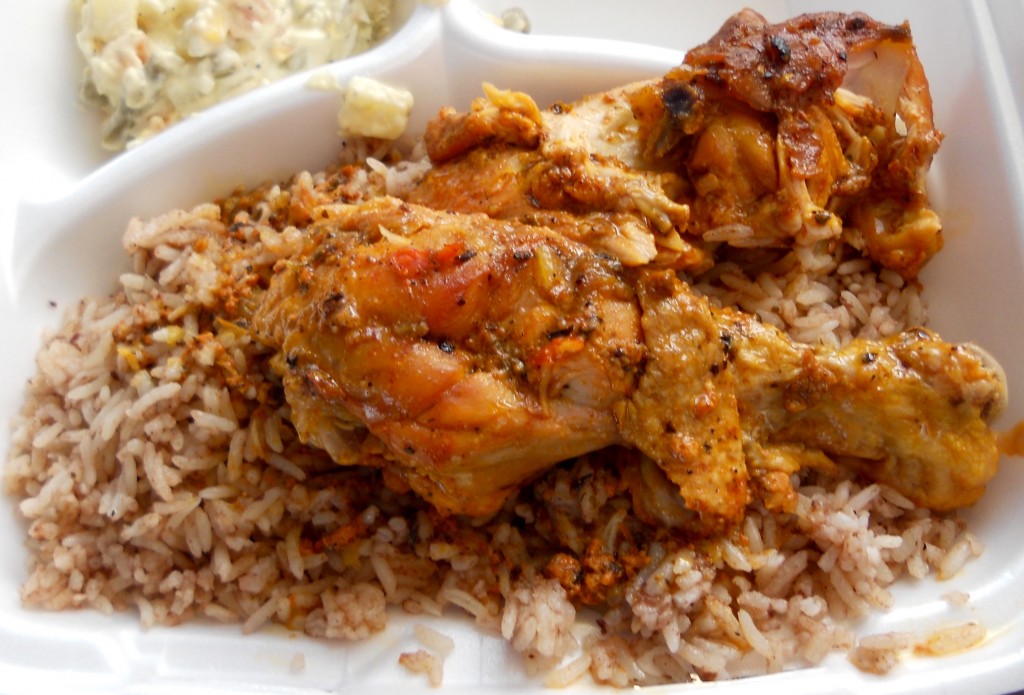 hunky bird
- Stew chicken ($10 for a heaping plate): a hunk of tasty bird, flash-fried and then stewed in “all three types of peppers”, as described by the wonderful Belizean chef.
- Meat pie ($1): probably a relic of English colonization, but with some glorious Caribbean flair.
- Coconut “brittle” ($1): like peanut brittle, but, um… with coconut, which makes everything better, including tarts.
- Coconut tarts (3 for $1): filled with a silky, cake-like coconut dough. Mmm… coconut.
- Baked coconut-ginger empanadas ($1): with enough ginger to bring back fond memories of spicy banana bread; so good, it’s almost unfair.
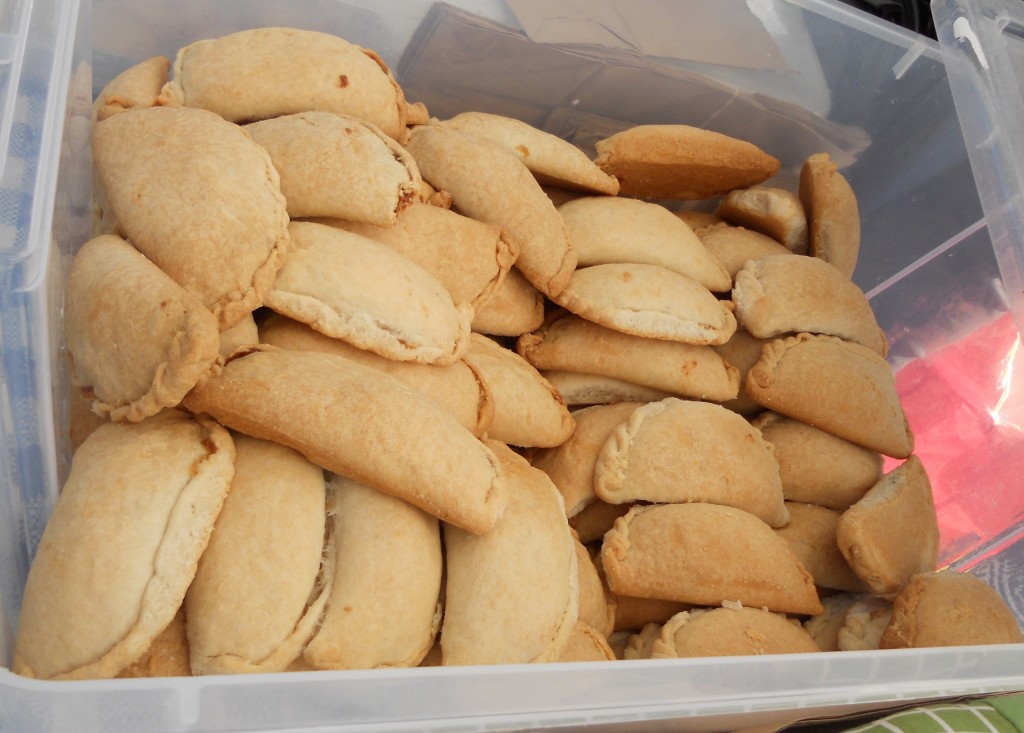 acres of coconut-ginger empanadas
But perhaps the biggest hit of the afternoon was the Belizean tamales ($3), offered by a quietly charming young man who was selling his uncle’s handmade treats. They were enormous – easily three times the size of their Mexican cousins – and stuffed with a spicy, saucy mix of vegetables and either pork or chicken. I’m a fan of tamales in all of their forms, but fresh, unusually spicy, supersized tamales make me particularly happy.
You know what else would make me happy? More acres of Garifuna food from Belize, Honduras, and elsewhere, preferably accompanied by a good Garifuna cookbook. Keep an eye on the Weiga/Let’s Eat website or Facebook page; more acres of Garifuna food (hudutu!) are hopefully coming soon.
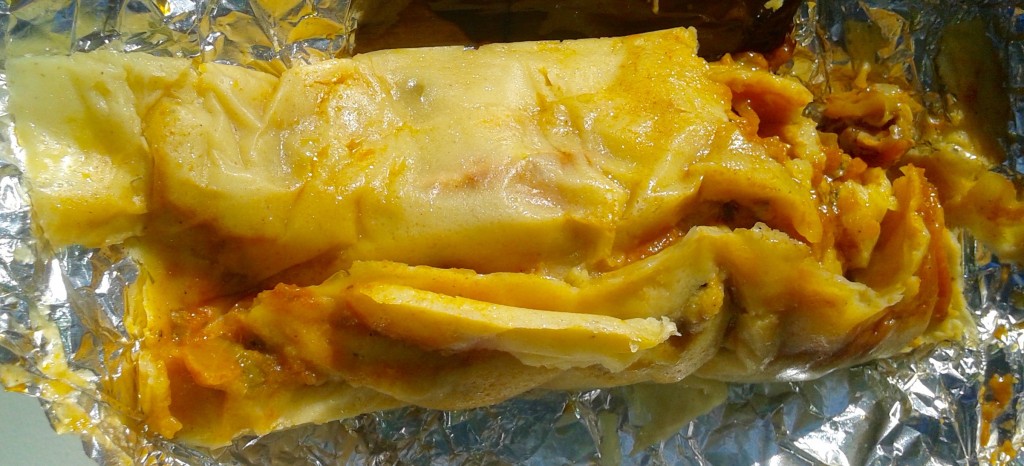
Linden Park vendors
Summer Sundays only
Subway: New Lots (L train) or Van Siclen (3, 4 trains)
|
|
View My Favs!
Search This Blog
Food By Region
|









































